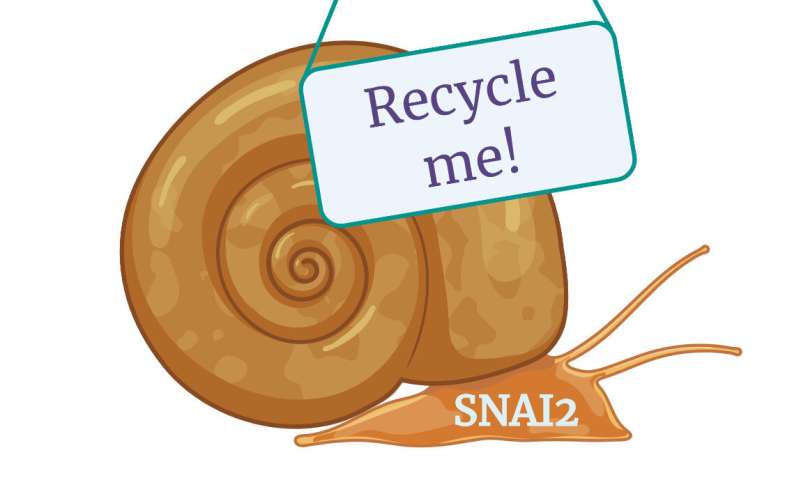
‘Do not erase.’ ‘Recycle me.’ ‘Free to a good home.’ Humans post these signs to indicate whether something has value or not, whether it should be disposed of or not. Inside our cells, a sophisticated recycling system uses its own enzymatic signs to flag certain cells for destruction—and a different set of enzymes can remove those flags.
Changing the balance between those two groups might provide a way to control a dangerous protein called SNAI2 that helps cancers metastasize, said Yibin Kang, Princeton University’s Warner-Lambert/Parke-Davis Professor of Molecular Biology, who has spent his career studying the cells and molecules behind metastatic cancers. His team has a pair of papers coming out in next month’s issue of Genes and Development, released online today.
The key is the cell’s recycling system. In 2004, the Nobel Prize was awarded to the three scientists who discovered that the body will shred proteins into tiny pieces after they are tagged with a ‘recycle me’ sign by a molecule called ubiquitin. Some scientists refer to ubiquitin as the ‘kiss of death,’ since once a protein has enough ubiquitin tags, that protein is headed on a one-way trip to the shredder—unless another enzyme comes along to remove its ‘recycle me’ sign.
Scientists call these rival teams ubiquitination ligases and deubiquitinases (DUBs). For simplicity, I’ll call them recyclers and dubs: The recyclers run around the body hanging “Recycle me!” signs on any protein that is damaged or has outstayed its welcome, while the dubs pull those signs down.
Unlike New Jersey’s single-stream recycling, cellular recyclers and dubs are remarkably specific, with some 600 recyclers and 100 dubs sharing the work of identifying the cell’s 20,000 proteins. After years of work, Kang’s team succeeded in identifying both the recycler and the dub for SNAI2: enzymes ASB13 and USB20, respectively.
“That specificity gives us another advantage in looking for drug treatments,” said Kang. “If you target this specific enzyme, it’s unlikely to cause side effects on other proteins.”
In both animal models and human breast cancer patients, Kang’s team found that in tumors with a high number of ASB13 recyclers, SNAI2 gets flagged for destruction in a timely way. On the other hand, the more USB20 dubs are around, the more SNAI2 is protected—leaving it to stick around to wreak havoc.
What’s so terrible about SNAI2?
SNAI2 weakens the connectors between cell surfaces that stick our cells together, allowing tumor cells to move around the body. In effect, it is a skeleton key, an all-access pass from one organ to another.
SNAI2 is not inherently bad; it plays an important role at key stages of development. But in healthy cells, SNAI2 only turns on for very narrow windows of time, such as during wound repair, when healthy cells need to move in to close the gap. In cancer patients, SNAI2 lingers, allowing cancer cells to use it to metastasize around the body.
In addition to increasing mobility, SNAI2 has two other tricks to help cancer cells: It makes them invisible to the immune system and resistant to chemotherapy.
Most importantly, while SNAI2 is in a family of proteins that are notoriously difficult to target with medications, recyclers and dubs are both vulnerable to drugs.
Source: Read Full Article